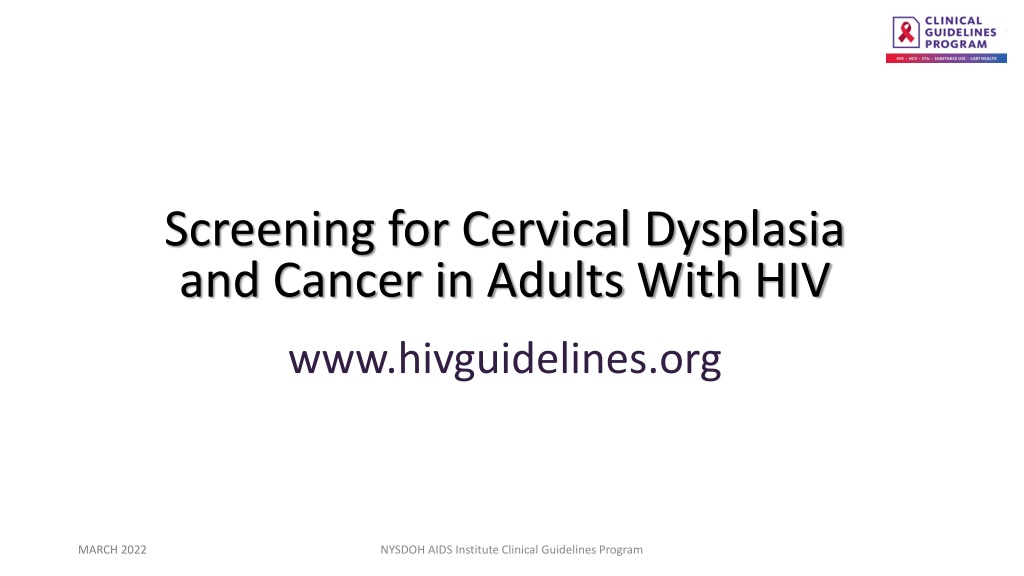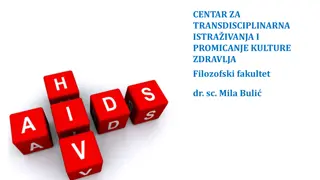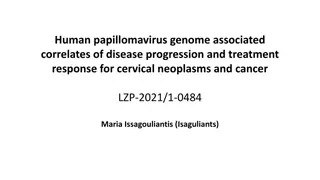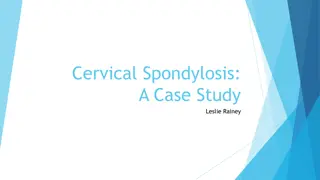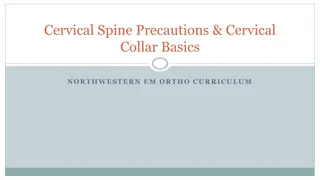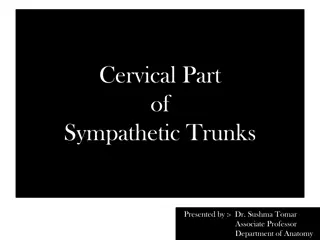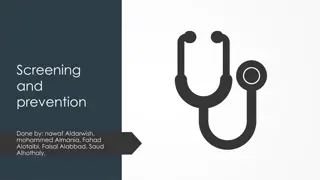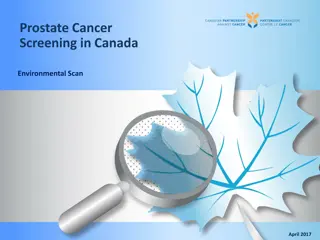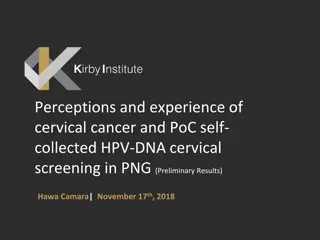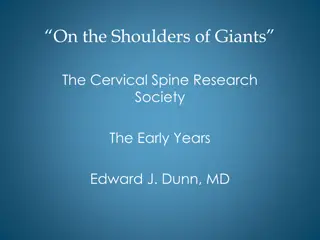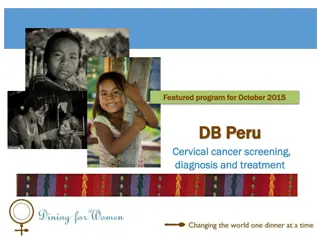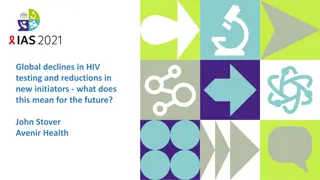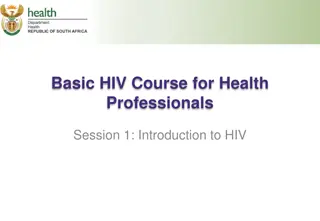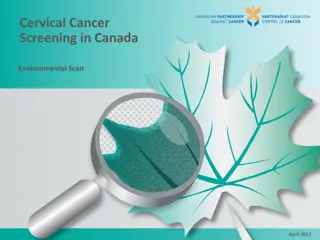Cervical Dysplasia and Cancer Screening in Adults with HIV
This clinical guideline emphasizes the importance of screening for cervical dysplasia and cancer in individuals with HIV. It provides recommendations for HPV prevention, vaccination, and cervical cancer prevention strategies. The guideline aims to increase screening rates, decrease morbidity and mortality associated with HPV-related diseases, and support prevention agendas for HIV patients.
Download Presentation

Please find below an Image/Link to download the presentation.
The content on the website is provided AS IS for your information and personal use only. It may not be sold, licensed, or shared on other websites without obtaining consent from the author.If you encounter any issues during the download, it is possible that the publisher has removed the file from their server.
You are allowed to download the files provided on this website for personal or commercial use, subject to the condition that they are used lawfully. All files are the property of their respective owners.
The content on the website is provided AS IS for your information and personal use only. It may not be sold, licensed, or shared on other websites without obtaining consent from the author.
E N D
Presentation Transcript
Screening for Cervical Dysplasia and Cancer in Adults With HIV www.hivguidelines.org MARCH 2022 NYSDOH AIDS Institute Clinical Guidelines Program
Purpose of This Guideline Purpose of This Guideline Increase the number of NYS residents with HIV who are screened for and receive effective medical management of cervical, vaginal, or vulvar dysplasia. Emphasize the role of ART-associated viral suppression in improving clearance or suppression of HPV, preventing cervical dysplasia, and reducing cervical cancer in individuals with HIV. Reduce the incident morbidity and mortality associated with genital HPV disease in individuals with HIV through vaccination against HPV and identification and treatment of precancerous lesions, when treatment is most successful, and cancerous lesions. Support the NYSDOH Prevention Agenda 2019-2024, which aims to increase cervical cancer screening by 5% among individuals who are 21 to 65 years old and have an annual income below $25,000. Integrate current evidence-based clinical recommendations into the healthcare- related implementation strategies of the NYS Ending the Epidemic initiative. MARCH 2022 NYSDOH AIDS Institute Clinical Guidelines Program www.hivguidelines.org
Recommendation: Recommendation: HPV Prevention HPV Prevention Given the increased lifetime risk of persistent HPV infection and increased prevalence of HPV-related cancers, clinicians should recommend the 9-valent HPV vaccine 3-dose series at 0, 2, and 6 months to all individuals with HIV who are 9 to 45 years old regardless of CD4 cell count, prior cervical or anal screening results, HPV test results, HPV-related cytologic changes, or other history of HPV-related lesions. (A3) MARCH 2022 NYSDOH AIDS Institute Clinical Guidelines Program www.hivguidelines.org
Key Points: Key Points: HPV Prevention HPV Prevention HPV vaccination status does not change the schedule of cervical cancer screening. HPV testing is not recommended before administration of the HPV vaccine. Inform patients with HIV about the risk of acquiring HPV and other STIs from close physical contact with the external genitalia, anus, cervix, vagina, urethra, mouth and oral cavity, or any other location where HPV lesions are present. Consistent and correct condom use remains an effective way to reduce the risk of transmission of most STIs, including HPV. However, inform patients that barrier protection such as condoms and dental dams may not fully protect against HPV. MARCH 2022 NYSDOH AIDS Institute Clinical Guidelines Program www.hivguidelines.org
Recommendations: Recommendations: Cervical Cancer Prevention Cervical Cancer Prevention In providing comprehensive primary care for adults with HIV, clinicians should ensure that patients at risk of cervical cancer receive age- and risk- appropriate screening (A3) and provide education about harm reduction measures that may reduce the risk, including: HPV vaccination (A2) ART to suppress HIV viral load (A2) Tobacco use cessation (A2) Sexual exposure prevention strategies, including using barrier protection (A3) and reducing the number of sex partners and associated sexual networks when possible (A3) Clinicians should establish a schedule for routine cervical screening based on a patient s medical history, anatomical inventory, age, and risk profile. (A2) MARCH 2022 NYSDOH AIDS Institute Clinical Guidelines Program www.hivguidelines.org
Recommendations: Recommendations: Screening for Cervical Abnormalities Screening for Cervical Abnormalities Clinicians should perform an anatomical inventory to identify patients eligible for screening. (A*) Clinicians should perform screening for cervical and genital tract dysplasia and cancer in patients with HIV who have or have had a cervix and meet the below criteria for age-based screening. (A2) Clinicians should perform physical examinations of the vulva, vagina, and anogenital perineum at least annually and at the time of cervical cytology and to assess interval complaints. (A3) Abnormal cytology results may reflect vaginal, vulvar, or anogenital dysplasia in the absence of cervical dysplasia. MARCH 2022 NYSDOH AIDS Institute Clinical Guidelines Program www.hivguidelines.org
Recommendations: Recommendations: Age Age- -Based Screening for Cervical Abnormalities Based Screening for Cervical Abnormalities For patients <30 years old, testing for HPV is not recommended (A2 ). For these patients, clinicians should perform cervical cytology within at least 2 years of the onset of receptive sexual activity or by age 21 years, regardless of the mode of HIV acquisition (A2), and if cytology results are normal, repeat testing every 3 years. (A2) For patients 30 years old, clinicians should perform cytology/HPV cotesting within 3 years of previous testing. (A2) If the baseline cytology and HPV test results are negative, clinicians should repeat both tests every 3 years thereafter. (A2) Clinicians should repeat cervical cytology after 2 months but within 4 months after a result of insufficient specimen for analysis has been reported. (A3) Clinicians should continue cervical cancer screening for patients 65 years old; however, factors such as a patient s life expectancy and risk of developing cervical cancer should inform shared decision-making regarding continued screening. (A3) MARCH 2022 NYSDOH AIDS Institute Clinical Guidelines Program www.hivguidelines.org
Recommendations: Recommendations: Concomitant Screening for Anal Cancer and STIs Concomitant Screening for Anal Cancer and STIs Clinicians should perform concomitant anal cytology. If appropriate follow-up of abnormal results is not available within the clinician s institution, a referral plan should be in place. For evidence-based recommendations, see the NYSDOH AI guideline Screening for Anal Dysplasia and Cancer in Patients With HIV. Regardless of a patient s cervical cytology results, clinicians should perform routine screening for STIs as recommended in the NYSDOH AI STI guidelines. MARCH 2022 NYSDOH AIDS Institute Clinical Guidelines Program www.hivguidelines.org
Recommendations: Recommendations: Post Post- -Hysterectomy and Post Hysterectomy and Post- -Cervical Excision Cervical Excision In patients with an intact cervix, clinicians should perform cervical cytology as above. (A*) In patients with HIV who have undergone total hysterectomy (uterus and cervix removed), clinicians should screen for vaginal intraepithelial neoplasia by performing vaginal cytology with HPV cotesting and manage as noted under age- based screening above. (A2 ) If a patient s hysterectomy was performed to treat HSILs, CIN 2 or CIN 3, or AIS [a], clinicians should perform 3 consecutive annual HPV tests, after which long- term surveillance should be initiated, with HPV testing every 3 years for 25 years. (A3) After a patient has undergone cervical excision, clinicians should perform cervical cytology with HPV testing as follows: at 6 months post-excision, annually until 3 sequential negative test results have been obtained, and every 3 years thereafter for at least 25 years. (A3) MARCH 2022 NYSDOH AIDS Institute Clinical Guidelines Program www.hivguidelines.org
Cytologic and Histologic Classifications of Cytologic and Histologic Classifications of Cervical Dysplasia Cervical Dysplasia Bethesda Classification System (describes cervical cytology results) Negative for intraepithelial lesion or malignancy (NILM) Atypical squamous cells of undetermined significance (ASC-US) Atypical squamous cells, high-grade squamous intraepithelial lesion cannot be excluded (ASC-H) Atypical glandular cells (AGC): endocervical cells, endometrial cells, or glandular cells Atypical glandular cells not otherwise specified (AGC- NOS) Atypical glandular cells favoring neoplasia (AGC-FN) Low-grade squamous intraepithelial lesions (LSIL) High-grade squamous intraepithelial lesions (HSIL) Squamous cell carcinoma Cancer Cervical intraepithelial lesion or neoplasia (describes histology obtained at biopsy) Atypia Low-grade cervical intraepithelial neoplasia (CIN 1) Moderate-grade cervical intraepithelial neoplasia; may be a low-grade or high-grade lesion (CIN 2) High-grade cervical intraepithelial neoplasia (CIN 3) Carcinoma in situ (CIS) Endocervical carcinoma in situ Cancer MARCH 2022 NYSDOH AIDS Institute Clinical Guidelines Program www.hivguidelines.org
Key Points: Key Points: Screening for Cervical Abnormalities Screening for Cervical Abnormalities Compassionate engagement in shared decision-making is crucial when navigating extended screening intervals or discontinuation of screening based on a patient s lifetime prognosis. When engaging patients in shared decision-making regarding screening intervals, consider duration of HIV infection, viral load and CD4 cell count over time, and history of abnormal Pap test results and anogenital HPV lesions. Cervical screening every 5 years may benefit virally suppressed patients adherent to HIV and primary care with negative cytology and negative HPV test results, no genital or pelvic complaints, no tobacco use, and no other cervical cancer risk factors. Inclusive and culturally sensitive healthcare includes a safe and welcoming environment that acknowledges the needs of transgender, transmasculine, transfeminine, and nonbinary patients. Ask patients to provide details about all gender-affirming and gynecologic surgical procedures they have undergone to help inform screening for HPV-related cancers. To facilitate accurate interpretation of cell morphology, note testosterone use and the presence of amenorrhea in the requisition for cervical cytology in transgender men. In individuals 30 years old, cytologic surveillance alone is acceptable only if HPV cotesting is unavailable. Cytology is less sensitive than HPV testing for detection of precancer and, therefore, requires testing at shorter, more frequent intervals. It is recommended that clinicians without access to HPV cotesting offer cytology at a minimum of 3-year intervals. MARCH 2022 NYSDOH AIDS Institute Clinical Guidelines Program www.hivguidelines.org
Recommendations: Recommendations: Screening for Cervical Dysplasia During Pregnancy Screening for Cervical Dysplasia During Pregnancy Clinicians should perform cervical cytology screening for pregnant patients with HIV as appropriate for each patient s age. (A2 ) Clinicians should refer pregnant patients for follow-up with experienced colposcopy providers when the following cervical cytology results are obtained: repeated ASC-US, ASC-US with HPV, negative cytology with persistently positive HPV, ASC-H, or LSIL or greater. (A3) When cervical dysplasia is diagnosed, clinicians should ensure that patients understand the potential risks and benefits and engage pregnant patients in shared decision-making regarding treatment. (A3) Clinicians should follow up on abnormal cytology or colposcopy results, ideally within 6 weeks postpartum. (A2) MARCH 2022 NYSDOH AIDS Institute Clinical Guidelines Program www.hivguidelines.org
Key Point: Key Point: Screening for Cervical Dysplasia During Pregnancy Screening for Cervical Dysplasia During Pregnancy Although cervical biopsies are not routinely recommended in pregnancy, any lesion suspicious for carcinoma in situ or cancer merits immediate evaluation with biopsy. MARCH 2022 NYSDOH AIDS Institute Clinical Guidelines Program www.hivguidelines.org
Recommendations: Recommendations: Follow Follow- -Up of Abnormal Cervical Cytology Results Up of Abnormal Cervical Cytology Results When a cervical cytology result of ASC-US is returned for a patient <30 years old or for a patient 30 years old who did not receive cotesting, the clinician should perform reflex HPV testing. (A2) If the reflex HPV test result is positive, the clinician should refer the patient for colposcopy. (A2) If the reflex HPV test result is negative, the clinician should repeat both the cervical cytology and HPV testing at 1 year. (A2) If at 1 year the cervical cytology and HPV test results are negative, the clinician should resume standard cervical cytology testing every 3 years. (A2) If at 1 year the cervical cytology result indicates ASC-US and the HPV test result is negative, the clinician should repeat cervical cytology and HPV testing 1 year following (A3); alternatively, if the patient has a history of cervical dysplasia or individual risk factors for cervical cancer, the clinician should refer for colposcopy. (A3) If at 1 year the HPV test result is positive, the clinician should refer the patient for colposcopy. (A2) When a patient of any age with HIV has a cervical cytology result of LSIL, HSIL, ASC-H, AGC, or AIS, the clinician should refer for colposcopy regardless of the HPV test result. (A2) MARCH 2022 NYSDOH AIDS Institute Clinical Guidelines Program www.hivguidelines.org
Follow Follow- -Up for Abnormal Up for Abnormal Cytology Results in Patients Cytology Results in Patients With HIV With HIV Abbreviations: ASC-H, atypical squamous cells, high- grade squamous intraepithelial lesion cannot be excluded; ASC-US, atypical squamous cells of undetermined significance; ASCCP, American Society for Colposcopy and Cervical Pathology; CIN, cervical intraepithelial neoplasia; HPV, human papillomavirus; HSIL, high-grade squamous intraepithelial lesion; LSIL, low-grade squamous intraepithelial lesion. Notes: a. In patients <30 years old, HPV reflex testing should be performed in patients with a positive cervical cytology result; in patients 30 years old, HPV cotesting is recommended. b. If cotesting was not performed, then HPV reflex testing is indicated following an abnormal cytology result. c. For non high-grade CIN, refer to ASCCP recommendations for management of LSIL (CIN 1) preceded by ASC-H or HSIL cytology. d. In patients <25 years old, immediate excision is not recommended; in nonpregnant patients 25 years old, the decision regarding expedited treatment versus colposcopy with biopsy should be based on shared decision-making between the patient and clinician. e. Perkins RB, Guido RS, Castle PE, et al. 2019 ASCCP Risk-based management consensus guidelines for abnormal cervical cancer screening tests and cancer precursors. J Low Genit Tract Dis 2020;24(2):102-131. [PMID: 32243307] MARCH 2022 NYSDOH AIDS Institute Clinical Guidelines Program www.hivguidelines.org
Follow Follow- -Up for Cervical Up for Cervical Cytology Results of AGC in Cytology Results of AGC in Patients With HIV Patients With HIV [a] Abbreviations: AGC, atypical glandular cells; ASCCP, American Society for Colposcopy and Cervical Pathology; HPV, human papillomavirus. Notes: a. Adapted with permission from the ASCCP. See Perkins RB, Guido RS, Castle PE, et al. 2019 ASCCP Risk- based management consensus guidelines for abnormal cervical cancer screening tests and cancer precursors. J Low Genit Tract Dis 2020;24(2):102-131. [PMID: 32243307] b. Conditions that increase risk for endometrial neoplasia include abnormal uterine bleeding, obesity, or conditions suggesting chronic anovulation. MARCH 2022 NYSDOH AIDS Institute Clinical Guidelines Program www.hivguidelines.org
Key Points: Key Points: Follow Follow- -Up of Abnormal Cervical Cytology Results Up of Abnormal Cervical Cytology Results Any cervical cytology result of AGC requires immediate follow-up with colposcopy and further evaluation. This committee strongly encourages all facilities that provide medical care for patients with HIV to develop a clinical pathway for the screening, diagnosis, and treatment of abnormal anal cytology results. MARCH 2022 NYSDOH AIDS Institute Clinical Guidelines Program www.hivguidelines.org
Recommendations: Recommendations: Management of Cervical Cancer Management of Cervical Cancer Clinicians should immediately refer patients with HIV and a diagnosis of cervical cancer to a gynecologic oncologist or surgeon trained in the management of cervical cancer. (A*) Clinicians should closely monitor patients with a history of cervical cancer with possible consultation with a gynecologic oncologist after definitive treatment for cancer, which may include surgery, radiation, and chemotherapy. (A3) MARCH 2022 NYSDOH AIDS Institute Clinical Guidelines Program www.hivguidelines.org
Need Help? Need Help? NYSDOH AIDS Institute Clinical Guidelines Program www.hivguidelines.org
Access the Guideline Access the Guideline www.hivguidelines.org > Screening for Cervical Dysplasia and Cancer in Adults With HIV Also available: Printable pocket guide and PDF NYSDOH AIDS Institute Clinical Guidelines Program www.hivguidelines.org
